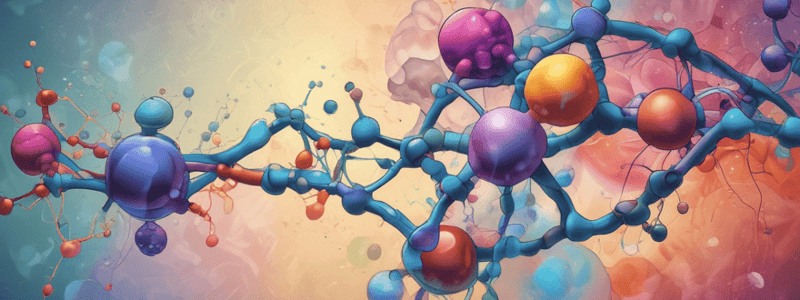Podcast
Questions and Answers
What are the three parts of a nucleotide?
What are the three parts of a nucleotide?
- Sugar, protein, phosphate backbone
- Sugar, lipid, base
- Sugar, base, phosphate backbone (correct)
- Base, lipid, phosphate backbone
What makes up a nucleoside?
What makes up a nucleoside?
- Phosphate and lipid
- Sugar and base (correct)
- Base and phosphate
- Sugar and phosphate
Which of the following functions is NOT associated with nucleotides?
Which of the following functions is NOT associated with nucleotides?
- Energy for metabolism
- Enzyme cofactors
- Transmission of genetic information (correct)
- Signal transduction
Which type of bond links nucleotide subunits together?
Which type of bond links nucleotide subunits together?
Which base pairs with adenine in DNA?
Which base pairs with adenine in DNA?
What forms the sugar-phosphate backbones of DNA strands?
What forms the sugar-phosphate backbones of DNA strands?
What is the function of the PolyA tail on mRNA?
What is the function of the PolyA tail on mRNA?
Which type of RNA has the greatest relative amount in cells involved in protein synthesis?
Which type of RNA has the greatest relative amount in cells involved in protein synthesis?
Which component is part of the 50S subunit of the bacterial ribosome?
Which component is part of the 50S subunit of the bacterial ribosome?
What is the molecular weight (Mr) of the eukaryotic 40S ribosomal subunit?
What is the molecular weight (Mr) of the eukaryotic 40S ribosomal subunit?
Which RNA type adapts amino acids to the codons in mRNA?
Which RNA type adapts amino acids to the codons in mRNA?
Which structural form does RNA adopt when it forms a helix?
Which structural form does RNA adopt when it forms a helix?
Which statement is correct about ribosomes?
Which statement is correct about ribosomes?
What is the role of transfer RNA (tRNA) in the cell?
What is the role of transfer RNA (tRNA) in the cell?
Which of the following RNAs is not directly involved in protein synthesis?
Which of the following RNAs is not directly involved in protein synthesis?
What are the components of a eukaryotic mRNA molecule?
What are the components of a eukaryotic mRNA molecule?
Which of the following is part of tRNA structure?
Which of the following is part of tRNA structure?
Which of the following is NOT a characteristic of RNA structure?
Which of the following is NOT a characteristic of RNA structure?
Flashcards are hidden until you start studying
Study Notes
Nucleotides
- A nucleotide consists of three parts: sugar, base, and phosphate backbone.
- Nucleosides are nucleotides without a phosphate group.
Nucleic Acids
- DNA and RNA are polymers of nucleotides.
- DNA and RNA have different functions:
- Storage of genetic information (DNA)
- Transmission of genetic information (mRNA)
- Processing of genetic information (ribozymes)
- Protein synthesis (tRNA and rRNA)
- Regulation of expression (siRNA and miRNA)
Functions of Nucleotides and Nucleic Acids
- Nucleotides have various functions:
- Energy for metabolism (ATP)
- Enzyme cofactors (NAD+)
- Signal transduction (cAMP)
- Nucleic acids have various functions:
- Storage of genetic information (DNA)
- Transmission of genetic information (mRNA)
- Processing of genetic information (ribozymes)
- Protein synthesis (tRNA and rRNA)
- Regulation of expression (siRNA and miRNA)
Helical Structure of DNA
- DNA consists of two chains of nucleotides coiled around each other in a right-handed double helix.
- Sugar-phosphate backbones of the two strands spiral around the outside of the helix.
- Nitrogenous bases extend into the centre at right angles to the axes of the helix.
Nucleotide Linkage
- Nucleotide subunits are linked together by phosphodiester bonds.
Hydrogen Bonding Between Base Pairs
- Hydrogen bonding is a non-covalent attraction that aids in maintaining the double helix structure.
- Adenine forms 2 H bonds with thymine (A=T).
- Cytosine forms 3 H bonds with guanine (G=C).
- This H bonding pattern is called base pairing.
RNA Types Involved in Protein Synthesis
- Ribosomal RNA (rRNA): 80%, range: 120-5070 nucleotides.
- Transfer RNA (tRNA): 15%, 75 nucleotides.
- Messenger RNA (mRNA): varies, varies.
RNA Structure
- RNA is intrinsically single-stranded.
- RNA cannot form a B-form helix due to a bulky 2'-OH.
- When helical, RNA adopts an A-form geometry.
- RNA has a deep and narrow major groove and a wide minor groove.
- Secondary structure is observed in rRNA and tRNA, and assumed to be in mRNA.
Messenger RNA (mRNA)
- mRNA carries the instructions for building a protein.
Types of RNA Molecules
- Messenger RNAs (mRNAs): intermediates that carry genetic information from DNA to the ribosomes.
- Transfer RNAs (tRNAs): adaptors between amino acids and the codons in mRNA.
- Ribosomal RNAs (rRNAs): structural and catalytic components of ribosomes.
- Small interfering RNAs (siRNA): RNA interference (RNAi).
- Long non-coding RNAs (long ncRNAs): transcription.
- MicroRNAs (miRNAs): RNA interference (RNAi).
- Ribozymes: RNA enzymes.
Eukaryotic mRNA
- Eukaryotic mRNA is capped at the 5' end.
- The 3' end is polyadenylated.
- PolyA tail is not coding.
- It is added after transcription.
- It stabilizes mRNA.
- Removal of polyA degrades RNA and inhibits translation.
Ribosomes
- Bacterial ribosome: Mr 2.7 x 106, 50S and 30S subunits.
- Eukaryotic ribosome: Mr 4.2 x 106, 60S and 40S subunits.
Ribosomal RNA (rRNA)
- rRNA is complex and makes up the ribosomes.
- Ribosomes are the "protein factories" and are composed of many proteins and rRNA molecules.
Transfer RNA (tRNA)
- tRNA acts as a translator between the nucleic acid and protein worlds.
- tRNA structure includes:
- Acceptor stem
- Anticodon stem
- 5' end
- 3' end
- Anticodon
- Amino acid
Studying That Suits You
Use AI to generate personalized quizzes and flashcards to suit your learning preferences.




